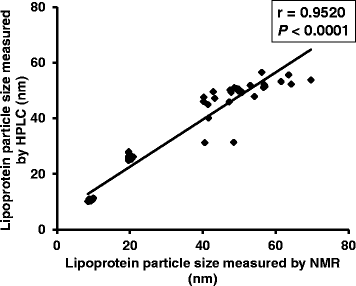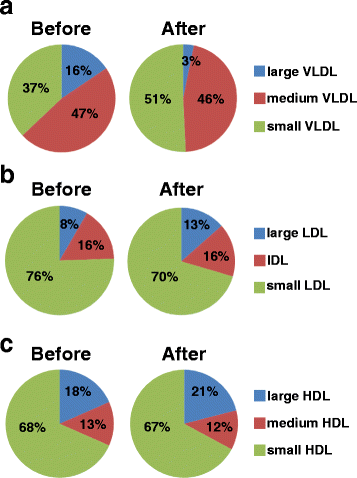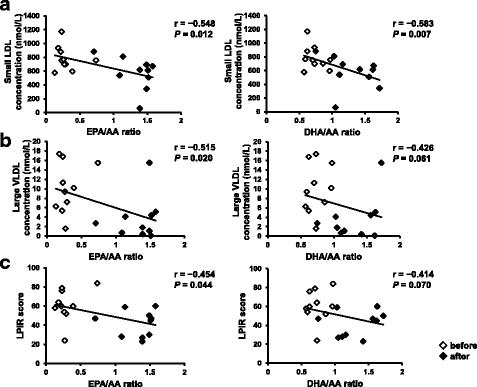N-3 polyunsaturated fatty acids improve lipoprotein particle size and concentration in Japanese patients with type 2 diabetes and hypertriglyceridemia: a pilot study
- PMID: 29544483
- PMCID: PMC5855932
- DOI: 10.1186/s12944-018-0706-8
N-3 polyunsaturated fatty acids improve lipoprotein particle size and concentration in Japanese patients with type 2 diabetes and hypertriglyceridemia: a pilot study
Abstract
Background: Patients with type 2 diabetes are at high risk for cardiovascular disease. Although hydroxymethylglutaryl-CoA reductase inhibitors (statins) can reduce cardiovascular events, residual risk remains even after target low-density lipoprotein cholesterol (LDL-C) levels have been achieved. Lipoprotein particle size and fraction changes are thought to contribute to such risks. The purpose of this study was to evaluate the effects of n-3 polyunsaturated fatty acids (n-3 PUFAs), predominantly eicosapentaenoic acid and docosahexaenoic acid, on lipoprotein particle size, concentration, and glycemic control in Japanese patients with type 2 diabetes and hypertriglyceridemia.
Methods: This was a multicenter, prospective, open-label, single arm study. We enrolled 14 patients with type 2 diabetes and hypertriglyceridemia treated with statins and dipeptidyl peptidase-4 inhibitors with glycated hemoglobin (HbA1c) < 8.0%, LDL-C < 120 mg/dL, and fasting triglyceride ≥150 mg/dL. After a 12-week observation period, they were treated with 4 g/day n-3 PUFAs for 12 weeks. Lipoprotein particle sizes, concentrations, lipoprotein insulin resistance (LPIR) scores, lipid profiles, HbA1c, and fasting plasma glucose (FPG) were measured before and after treatment. Lipoprotein profiles were measured by nuclear magnetic resonance spectroscopy. Data were analyzed using Wilcoxon signed-rank tests.
Results: Concentrations of total cholesterol (P < 0.001), LDL-C (P = 0.003), and triglyceride (P < 0.001) decreased following n-3 PUFA administration. N-3 PUFAs decreased the size of very low-density lipoprotein (VLDL; P < 0.001) particles, but did not affect LDL or high-density lipoprotein (HDL) particles. The concentration of large LDL increased, whereas small LDL decreased, causing the large to small LDL ratio to increase significantly (P = 0.042). Large VLDL and chylomicron concentrations significantly decreased, as did the large to small VLDL ratio (all P < 0.001). FPG levels unchanged, whereas HbA1c levels slightly increased. LPIR scores improved significantly (P = 0.001).
Conclusions: N-3 PUFAs partly improved atherogenic lipoprotein particle size and concentration, and produced less atherogenic lipoprotein subclass ratios in patients that achieved target LDL-C levels and glycemic control. These results suggest that n-3 PUFAs may reduce residual cardiovascular risk factors in statin-treated patients with type 2 diabetes and hypertriglyceridemia.
Trial registration: The study was registered at UMIN-ID: UMIN000013776 .
Keywords: Cardiovascular risk; Dipeptidyl peptidase-4 inhibitor; Hydroxymethylglutaryl-CoA reductase inhibitor; Hypertriglyceridemia; Lipoprotein; Low-density lipoprotein cholesterol size; N-3 polyunsaturated fatty acids; Small dense low-density lipoprotein cholesterol; Type 2 diabetes.
Conflict of interest statement
Ethics approval and consent to participate
The study protocol was approved by the following Institutional Review Boards: Institutional Review Board of Chiba University Hospital (ID number: G25019) and National Hospital Organization Chiba Medical Center Research Review Board. Tokuyama Clinic was assessed at the Institutional Review Board of Chiba University Hospital, which was the centralized IRB (ID number: N25031). Signed written informed consent was obtained from all patients. The study was conducted in full compliance with the articles of the Declaration of Helsinki.
Consent for publication
Not applicable.
Competing interests
The authors declare that they have no competing interests.
Publisher’s Note
Springer Nature remains neutral with regard to jurisdictional claims in published maps and institutional affiliations.
Figures



Similar articles
-
Effects of omega-3 carboxylic acids on lipoprotein particles and other cardiovascular risk markers in high-risk statin-treated patients with residual hypertriglyceridemia: a randomized, controlled, double-blind trial.Lipids Health Dis. 2015 Sep 2;14:98. doi: 10.1186/s12944-015-0100-8. Lipids Health Dis. 2015. PMID: 26328624 Free PMC article. Clinical Trial.
-
Effects of icosapent ethyl on lipoprotein particle concentration and size in statin-treated patients with persistent high triglycerides (the ANCHOR Study).J Clin Lipidol. 2015 May-Jun;9(3):377-83. doi: 10.1016/j.jacl.2014.11.009. Epub 2014 Nov 29. J Clin Lipidol. 2015. PMID: 26073397 Clinical Trial.
-
Association of Lipoproteins, Insulin Resistance, and Rosuvastatin With Incident Type 2 Diabetes Mellitus : Secondary Analysis of a Randomized Clinical Trial.JAMA Cardiol. 2016 May 1;1(2):136-45. doi: 10.1001/jamacardio.2016.0096. JAMA Cardiol. 2016. PMID: 27347563 Free PMC article. Clinical Trial.
-
Beyond low-density lipoprotein: addressing the atherogenic lipid triad in type 2 diabetes mellitus and the metabolic syndrome.Am J Cardiovasc Drugs. 2005;5(6):379-87. doi: 10.2165/00129784-200505060-00005. Am J Cardiovasc Drugs. 2005. PMID: 16259526 Review.
-
Association Between Triglyceride Lowering and Reduction of Cardiovascular Risk Across Multiple Lipid-Lowering Therapeutic Classes: A Systematic Review and Meta-Regression Analysis of Randomized Controlled Trials.Circulation. 2019 Oct 15;140(16):1308-1317. doi: 10.1161/CIRCULATIONAHA.119.041998. Epub 2019 Sep 18. Circulation. 2019. PMID: 31530008 Free PMC article.
Cited by
-
N-3 fatty acid supplementation mediates lipid profile, including small dense LDL, when combined with statins: a randomized double blind placebo controlled trial.Lipids Health Dis. 2022 Sep 1;21(1):84. doi: 10.1186/s12944-022-01686-y. Lipids Health Dis. 2022. PMID: 36050695 Free PMC article. Clinical Trial.
-
Novel Pharmaceutical and Nutraceutical-Based Approaches for Cardiovascular Diseases Prevention Targeting Atherogenic Small Dense LDL.Pharmaceutics. 2022 Apr 9;14(4):825. doi: 10.3390/pharmaceutics14040825. Pharmaceutics. 2022. PMID: 35456658 Free PMC article. Review.
-
Omega 3 rich diet modulates energy metabolism via GPR120-Nrf2 crosstalk in a novel antioxidant mouse model.Biochim Biophys Acta Mol Cell Biol Lipids. 2019 Apr;1864(4):466-488. doi: 10.1016/j.bbalip.2019.01.002. Epub 2019 Jan 16. Biochim Biophys Acta Mol Cell Biol Lipids. 2019. PMID: 30658097 Free PMC article.
-
Distinct Differences in Lipoprotein Particle Number Evaluation between GP-HPLC and NMR: Analysis in Dyslipidemic Patients Administered a Selective PPARα Modulator, Pemafibrate.J Atheroscler Thromb. 2021 Sep 1;28(9):974-996. doi: 10.5551/jat.60764. Epub 2021 Feb 2. J Atheroscler Thromb. 2021. PMID: 33536398 Free PMC article. Clinical Trial.
-
Plasma fatty acid metabolic profiling coupled with clinical research reveals the risk factors for atherosclerosis development in type 2 diabetes mellitus.RSC Adv. 2019 Nov 6;9(62):36162-36170. doi: 10.1039/c9ra07634d. eCollection 2019 Nov 4. RSC Adv. 2019. PMID: 35540605 Free PMC article.
References
-
- Sone H, Tanaka S, Tanaka S, Iimuro S, Oida K, Yamasaki Y, et al. Serum level of triglycerides is a potent risk factor comparable to LDL cholesterol for coronary heart disease in Japanese patients with type 2 diabetes: subanalysis of the Japan diabetes complications study (JDCS) J Clin Endocrinol Metab. 2011;96:3448–3456. doi: 10.1210/jc.2011-0622. - DOI - PubMed
Publication types
MeSH terms
Substances
LinkOut - more resources
Full Text Sources
Other Literature Sources
Medical

